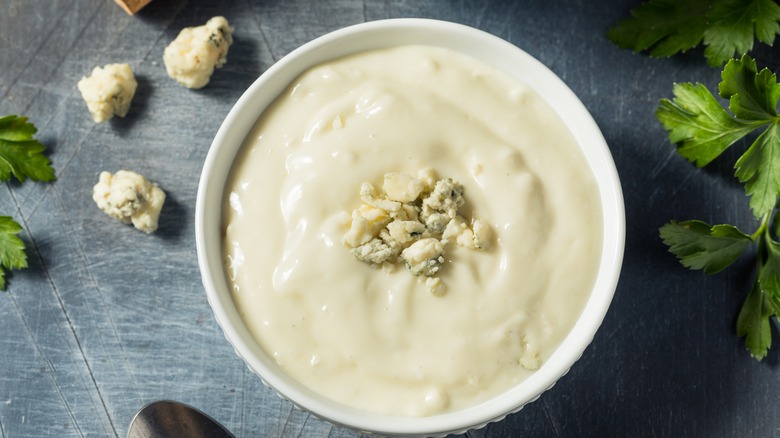Are Blue Cheese Dressing And Dip The Same Thing?
Blue cheese, or bleu cheese as it's commonly known, can be a bit divisive. It has a strong flavor and a thick crumbly texture. People seem to love it or hate it. While some people may drool over the idea of eating a chunk of Roquefort with a pear and a baguette in Paris, others would rather eat a shoe. Many dislike blue cheese because they don't like the blue color that is, for all intents and purposes, mold.
While it's a common belief that mold is bad, the truth is that blue cheese is in no way harmful to eat, per Medical News Today. Those that insist they hate blue cheese might be swayed if they tried a variety of it that is softer and more subtle.
One way to enjoy the flavor of blue cheese is in a dip or dressing, which tend to have much milder flavors. When it comes to eating blue cheese dip and dressing, the question arises — are they the same? And can these two condiments be used interchangeably?
The dressing vs. dip debate
When it comes to knowing the difference between a dip and a dressing, the biggest deciding factor is texture and consistency. There are many variations of blue cheese dressing and dip, but both typically start with a similar base of mayo, sour cream or yogurt, lemon juice, and fresh herbs. Blue cheese dips are often the star ingredient on a veggie platter, rather than a supporting role, so they are thicker and have a more concentrated blue cheese flavor.
On the contrary, if you're looking to make a blue cheese dressing, or even turn a blue cheese dip into a dressing, you'll want to thin it out a bit. Adding a bit of white vinegar, lemon juice,or even buttermilk can turn a tasty blue cheese dip into the perfect consistency to be used as a dressing.
Blue cheese dressing adds a salty, umami-packed bite to your favorite salad and also highlights a heartier salad like a modern wedge perfectly. If nibbling on blue cheese feels too intense for your taste buds, try a dip or dressing to enjoy those bold flavors toned down a notch.

